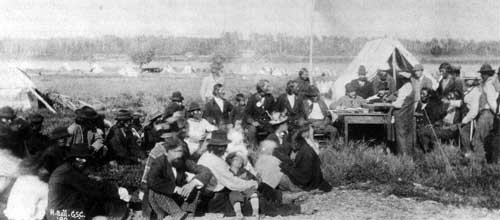The Anishinaabe (Anishinabewaki, Anishinabe, Anihšināpē, Nishnaabe, Neshnabé and Anishinabek) homelands cover a vast swath of territory in the Great Lakes and westward. They stretch from Georgian Bay on Lake Huron to the northwestern shores of Lake Superior. After the Iroquois Wars, however, the Anishinaabe population was most concentrated between Sault Ste. Marie and Michilimackinac. Three distinct peoples, the Ojibwe, the Odawa, and the Potawatomi make up the collective Anishinaabe, called the Council of Three Fires (Niswi-mishkodewin). The Ojibwe are the westernmost people of the Council of Three Fires, whose territory stretches from Sault Ste. Marie to western Lake Superior; at time of European contact they lived near prominent sturgeon fisheries and trade centres such as Grand Portage, Chequamegon, Kaministiquia, Nipigon, and Michipicoton.
In the mid-eighteenth century, the Hudson’s Bay Company and the Montréal-based North West Company expanded the fur trade into the Hudson Bay Watershed. Concurrently, in 1781-82, a continent-wide smallpox epidemic decimated half to two-thirds of the Cree and Nakoda population of the Hudson Bay Watershed. Subsequently, the Ojibwe moved west into recently depopulated Cree and Nakoda territories, which were fur and resource-rich. Moving into the Parkland and Prairies during the last decades of the eighteenth century, the Ojibwe lived among and intermarried with the Cree and Nakoda who maintained their presence after the epidemics. Throughout much of their history on the Plains, the Ojibwe developed a Plains-oriented identity and way of life in tandem with their Cree and Nakoda neighbors with whom they traded, intermarried, and fought against common enemies, particularly the Lakota and Gros Ventre. The Ojibwe, Cree, and Nakoda formed strong allies and kinship relations with each other, communities were formed out of these partnerships and alliances.

Notably, Chief Peguis, who was among the Ojibwe who migrated west with the fur trade in the late 1790s settling on the Red River, welcomed the first Scottish settlers brought to the Red River Valley by Lord Selkirk in 1812 and even aided and defended them during the difficult years of their conflict with the NWC and the Métis. Beyond entertaining relatively good relations with the HBC and the NWC, in 1871 the Ojibwe were prominent negotiators and signatories in Treaties 1 and 2 of southern Manitoba. As with many Indigenous peoples in Canada, with the decline of fur trade the Ojibwe were forced into reliance on wage labour and government assistance for survival, as the implementation of reserves and other Settler Colonial policies disrupted their lifeways and isolated them onto small parcels of land. In addition, Ojibwe peoples resisted territorial encroachment, economic discouragement (prohibited from selling grains, livestock, harvest, and other goods/sundries), and assimilation instituted through residential schools. Notable Ojibwe communities in western Canada are Cote First Nation, Cowessess First Nation, Ebb and Flow First Nation, Gordon First Nation, and Keeseekoose First Nation. The Ojibwe are also known (both contemporarily and in historical documents) as the Ojibwa, Ojibway, Chippewa, Saulteaux, and Bungi.

Resources:
- Saulteaux - Indigenous Saskatchewan Encyclopedia | University of Saskatchewan (usask.ca)
- The Ojibwe People | Historic Fort Snelling | Minnesota Historical Society
- The Teachings of the Bear Clan: As Told By Saulteaux Elder Danny Musqua
- Warren, William Whipple. History of the Ojibway People. St. Paul: Minnesota Historical Society, 1885. (REPRINTED, 1984)
- Hickerson, Harold. The Chippewa and Their Neighbors: A Study in Ethnohistory. Toronto: Holt, Rinehart and Winston, 1970.
- Bishop, Charles A. The Northern Ojibwa and the Fur Trade: An Historical and Ecological Study. Toronto: Holt, Rinehart and Winston, 1974.
- Peers, Laura. The Ojibwa of Western Canada, 1780 to 1870. Winnipeg: University of Manitoba Press, 1994.
